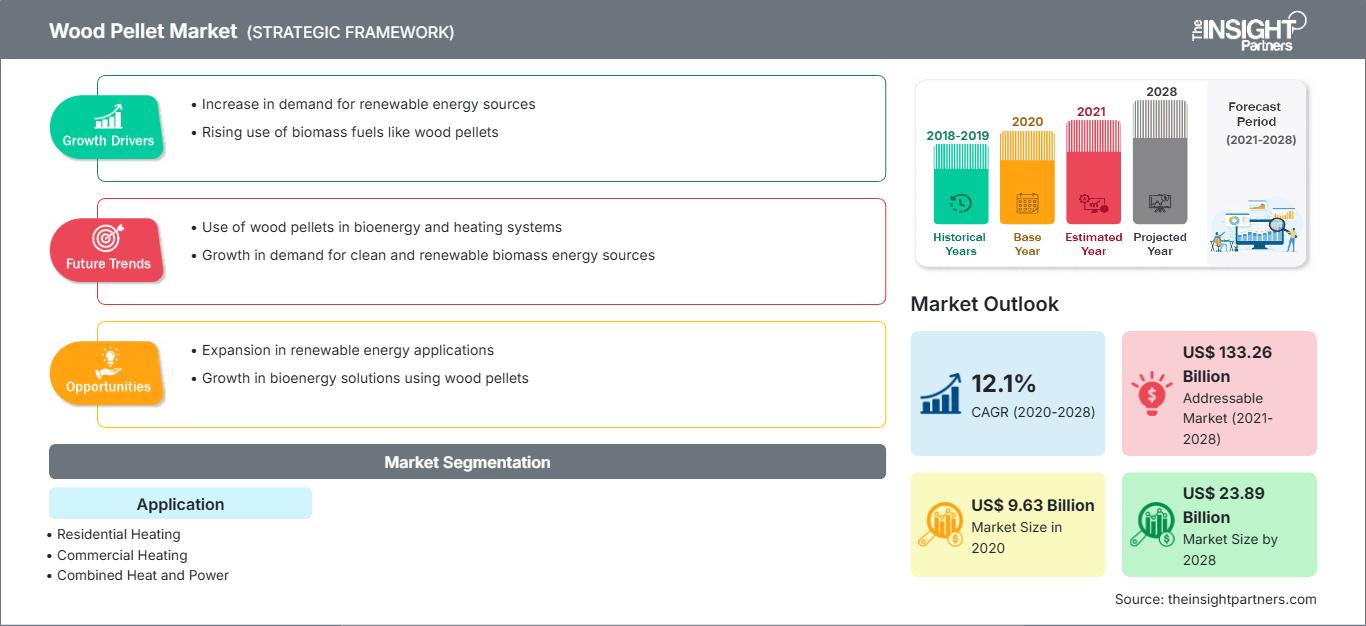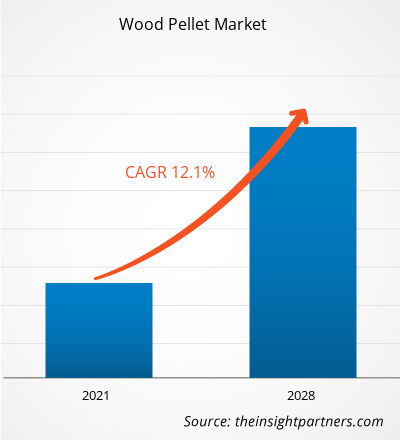The wood pellet market was valued at US$ 9,630.99 million in 2020 and is projected to reach US$ 23,892.77 million by 2028; it is expected to grow at a CAGR of 12.1% from 2021 to 2028.
Wood pellets are produced using finely ground wood bark; they are majorly used as fuel. These are extensively used in residential houses for efficient burning in smaller stoves. Wood pellets are produced from numerous wood waste products and are considered a source of renewable energy. Currently, along with residential heating, there is increased use of wood pellets for power generation across the globe. These are largely utilized globally as a fuel, which is expected to increase the demand for wood pellets in the coming years. Europe is the leading region for the consumption of wood pellets for power generation. Moreover, North America is the significant exporter of wood pellets, which is expected to increase the production facilities of wood pellets in the coming years.
In 2020, Europe contributed to the largest share in the global market. An annual report filed with the USDA Foreign Agricultural Service’s Global Agriculture Information Network represents that the wood pellet market in Europe has been relatively unaffected by the COVID-19 pandemic. As per the report, the region consumed ~29 million metric tons of wood pellets in 2018, which makes it the world’s largest pellet market. Wood pellets are used in residential applications for heating purposes and industrial heat and power generation. The report further states that the region contributes ~30% of world pellet production currently. However, it accounts for the major consumption of wood pellets across the globe. Italy, Germany, and other such countries are considered as the major growth markets for consuming wood pellets in residential heating applications. The UK is one of the major consumers of wood pellets, followed by Italy and Denmark.
The global wood pellets market has faced many challenges from the impact of the COVID-19 outbreak. The ongoing COVID-19 pandemic has drastically altered the status of the chemical & materials sector and negatively impacted the growth of the wood pellet market. The implementation of measures to combat the spread of the virus has aggravated the situation and affected the growth of several industrial sectors. The market has been impacted by the sudden distortion in operational efficiencies and disruptions in the value chains attributable to the sudden closure of national and international boundaries. Disruptions in terms of sourcing of raw materials from suppliers and temporary closures of manufacturing bases due to indefinite lockdowns and temporary quarantines have impacted the growth of the market during the pandemic. As per a news published by Woodcote Media Ltd on 30 July 2020, a survey conducted by ENplus a certification scheme for wood pellets stated that 75% of certified producers have been negatively impacted by the COVID-19 pandemic. The companies are planning to revise the prices of wood pellets for end users. However, the same report represented that approximately 5% of respondents believe that there is a slight increase in demand for wood pellets from end users. Similarly, the wood supply chain has been impacted by the pandemic, which has resulted in disruptions in raw material supply and prices.
Customize This Report To Suit Your Requirement
You will get customization on any report - free of charge - including parts of this report, or country-level analysis, Excel Data pack, as well as avail great offers and discounts for start-ups & universities
Wood Pellet Market: Strategic Insights

-
Get Top Key Market Trends of this report.This FREE sample will include data analysis, ranging from market trends to estimates and forecasts.
Market Insights
Growing Awareness About Use of Renewable Energy Sources
Renewable energy plays a vital role in meeting the future energy needs in both rural and urban areas. The scarcity of resources, along with an increase in awareness about adverse environmental impacts of fossil-based products and processes, has surged the dependency on renewable energy sources such as wood pellets. The growing need for sustainable energy development is yet another factor contributing to the increased demand for wood pellets. Renewable energy resources and technologies are considered environment-friendly alternatives as they generally cause limited or no impact on the environment compared to other forms of energy sources. Further, such resources are easily available and cannot be depleted.
Wood pellets are categorized under renewable energy sources as they are derived from trees and are a form of biomass. Wood pellets are composed of dried and compressed wood fibers prepared from sawmill residuals, logging debris such as forest debris piles, and whole logs. According to the US Energy Information Administration, biomass is categorized as an organic material that can be effectively used as a source of energy. Several forms of biomass such as wood pellets are carbon neutral and leave a net-zero carbon footprint upon burning biomass.
Type Insights
Based on application, the global wood pellet market is segmented into residential heating, commercial heating, CHP (combined heat and power), and power generation. The residential heating segment led the global wood pellets market in 2020. Wood-fueled systems are commonly used worldwide for residential heating, and recently wood pellets have been replacing traditional firewood. Wood pellet boilers for residential heating applications promise low emissions, high efficiency, and automatic operation. Wood pellets are used for residential heating in pellet stoves. They are also used in pellet boilers to generate heat, steam, and electricity in the service industry, power generation, and manufacturing. It is used for power generation and heat generation in the manufacturing and energy sectors, which is driving the wood pellet market. Since the cost of wood pellets remained cheaper than that of other fuels for a long time, it becomes a more economical option, addressing the primary concern of the residential sector. As a renewable energy source, wood pellets had received incentives and subsidies from the governments in several countries. In recent years, many countries either launched or updated their policies and schemes related to wood pellets for heating applications.
Key market players operating in the wood pellet market include Pacific BioEnergy, Premium Pellet Ltd., Pinnacle Renewable Energy, Enviva, ANDRITZ, Wood & Sons, Graanul Invest, New England Wood Pellet, TANAC, and Energex Pellet Fuel, Inc.
Report Spotlights
- Progressive industry trends in the global wood pellet market to help players develop effective long-term strategies
- Business growth strategies adopted by developed and developing markets
- Quantitative analysis of the global wood pellet market from 2019 to 2028
- Estimation of the demand for wood pellet market across various industries
- PEST analysis to illustrate the efficacy of buyers and suppliers operating in the industry to predict the market growth
- Recent developments to understand the competitive market scenario and the demand for wood pellets
- Market trends and outlook, coupled with factors driving and restraining the growth of the wood pellet market
- Decision-making process by understanding strategies that underpin commercial interest with regard to global wood pellet market growth
- Wood pellet market size at various nodes of market
- Detailed overview and segmentation of the global wood pellet market, as well as its dynamics in the industry
- Wood pellet market size in various regions with promising growth opportunities
The regional trends and factors influencing the Wood Pellet Market throughout the forecast period have been thoroughly explained by the analysts at The Insight Partners. This section also discusses Wood Pellet Market segments and geography across North America, Europe, Asia Pacific, Middle East and Africa, and South and Central America.
Wood Pellet Market Report Scope
| Report Attribute | Details |
|---|---|
| Market size in 2020 | US$ 9.63 Billion |
| Market Size by 2028 | US$ 23.89 Billion |
| Global CAGR (2020 - 2028) | 12.1% |
| Historical Data | 2018-2019 |
| Forecast period | 2021-2028 |
| Segments Covered |
By Application
|
| Regions and Countries Covered |
North America
|
| Market leaders and key company profiles |
|
Wood Pellet Market Players Density: Understanding Its Impact on Business Dynamics
The Wood Pellet Market is growing rapidly, driven by increasing end-user demand due to factors such as evolving consumer preferences, technological advancements, and greater awareness of the product's benefits. As demand rises, businesses are expanding their offerings, innovating to meet consumer needs, and capitalizing on emerging trends, which further fuels market growth.

- Get the Wood Pellet Market top key players overview
The report segments the global wood pellet market as follows:
Wood Pellet Market, by Application
- By Application the Global Wood Pellet Market is segmented Residential Heating, Commercial Heating, Combined Heat and Power (CHP), and Power Generation.
Company Profiles
- Pacific BioEnergy
- Premium Pellet Ltd.
- Pinnacle Renewable Energy
- Enviva
- ANDRITZ
- Wood & Sons
- Graanul Invest
- New England Wood Pelletv5/8520
- TANAC
- Energex Pellet Fuel, Inc.
Frequently Asked Questions
Which region held the fastest CAGR in the global wood pellet market?
Based on application, why is the residential heating segment expected to grow at the highest rate during 2022–2028?
Can you list some of the major players operating in the global wood pellet market?
Which region held the largest share of the global wood pellet market?
- Historical Analysis (2 Years), Base Year, Forecast (7 Years) with CAGR
- PEST and SWOT Analysis
- Market Size Value / Volume - Global, Regional, Country
- Industry and Competitive Landscape
- Excel Dataset
Recent Reports
Related Reports
Testimonials
Reason to Buy
- Informed Decision-Making
- Understanding Market Dynamics
- Competitive Analysis
- Identifying Emerging Markets
- Customer Insights
- Market Forecasts
- Risk Mitigation
- Boosting Operational Efficiency
- Strategic Planning
- Investment Justification
- Tracking Industry Innovations
- Aligning with Regulatory Trends





















 Get Free Sample For
Get Free Sample For